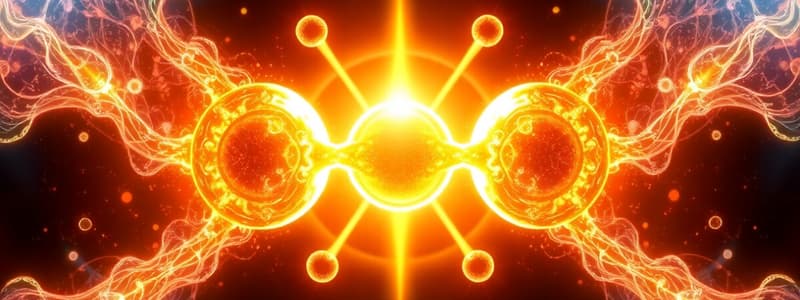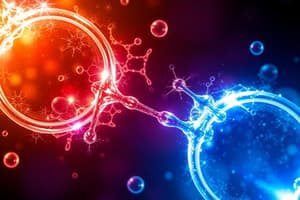Podcast
Questions and Answers
What type of bonding allows charge to flow when in a solution?
What type of bonding allows charge to flow when in a solution?
- Ionic bonding (correct)
- Network bonding
- Covalent bonding
- Metallic bonding
What is the correct name for the compound represented by the formula MgCl2?
What is the correct name for the compound represented by the formula MgCl2?
- Magnesium chloride (correct)
- Magnesium chlorate
- Dichloro magnesium
- Magnesium dichloride
Which of the following compounds features a low melting point?
Which of the following compounds features a low melting point?
- Copper sulphate
- Sodium chloride
- Diamond
- Covalent molecules (correct)
In naming compounds, what is the suffix added to the second element if only two elements are present?
In naming compounds, what is the suffix added to the second element if only two elements are present?
What is the valency of elements in Group 6?
What is the valency of elements in Group 6?
Which equation correctly demonstrates a word equation?
Which equation correctly demonstrates a word equation?
What is the formula mass of water (H2O)?
What is the formula mass of water (H2O)?
What prefix indicates 'three' when naming a compound?
What prefix indicates 'three' when naming a compound?
What type of bonding occurs between two non-metal atoms?
What type of bonding occurs between two non-metal atoms?
Which of the following substances does NOT consist of covalent bonds?
Which of the following substances does NOT consist of covalent bonds?
Which statement best describes the melting and boiling points of covalent molecular substances?
Which statement best describes the melting and boiling points of covalent molecular substances?
What is formed when a metal atom loses its outer electrons?
What is formed when a metal atom loses its outer electrons?
Which type of bonding is responsible for the conductivity of metals?
Which type of bonding is responsible for the conductivity of metals?
Why do ionic compounds only conduct electricity when molten or in solution?
Why do ionic compounds only conduct electricity when molten or in solution?
Which of the following best describes the properties of covalent network substances?
Which of the following best describes the properties of covalent network substances?
Which statement accurately reflects the principle of solubility described in the content?
Which statement accurately reflects the principle of solubility described in the content?
Flashcards
Covalent bonding
Covalent bonding
A shared pair of electrons between two non-metal atoms.
Diatomic elements
Diatomic elements
Elements that exist as two atoms bonded together by a covalent bond.
Molecular compounds
Molecular compounds
Substances formed by covalent bonds between non-metal atoms, having specific shapes.
Electrostatic force
Electrostatic force
Signup and view all the flashcards
Ionic lattice
Ionic lattice
Signup and view all the flashcards
Free movement of electrons
Free movement of electrons
Signup and view all the flashcards
Solubility of ionic compounds
Solubility of ionic compounds
Signup and view all the flashcards
Electrical conductivity of ionic compounds
Electrical conductivity of ionic compounds
Signup and view all the flashcards
Ionic Bonding
Ionic Bonding
Signup and view all the flashcards
Metallic Bonding
Metallic Bonding
Signup and view all the flashcards
Electrolyte
Electrolyte
Signup and view all the flashcards
Chemical Equation
Chemical Equation
Signup and view all the flashcards
Chemical Formula
Chemical Formula
Signup and view all the flashcards
Formula Mass
Formula Mass
Signup and view all the flashcards
Valency
Valency
Signup and view all the flashcards
Study Notes
Covalent Bonding
- Occurs between two non-metal atoms
- A shared pair of electrons forms a covalent bond
- Eight diatomic elements held by covalent bonding: Hydrogen (H₂), Oxygen (O₂), Nitrogen (N₂), and the Group 7 elements (Halogens)
- Molecular compounds (e.g., water (H₂O), ammonia (NH₃), methane (CH₄)) have specific shapes due to covalent bonds
- Covalent molecular substances have low melting and boiling points due to weak bonds between molecules
- Covalent network substances (e.g., diamond, graphite, silicon dioxide) have high melting and boiling points due to strong covalent bonds
- These strong covalent bonds hold atoms tightly together
Ionic Bonding
- Occurs between a metal and a non-metal atom
- Forms charged particles called ions
- Metal loses outer electrons to become a positive ion
- Non-metal gains electrons to become a negative ion
- Electrostatic forces hold the oppositely charged ions strongly together in a lattice structure
- Ionic compounds have high melting and boiling points
Solubility
- "Like dissolves like" - ionic compounds dissolve in polar solvents, like water
- Covalent compounds dissolve in covalent solvents, like hexane
Electrical Conductivity
- Metals conduct electricity when solid or liquid due to free-moving electrons
- Covalent compounds do not conduct electricity
- Ionic compounds only conduct electricity when molten (liquid) or in solution due to ions being free to move
Metallic Bonding
- Found in metal elements
- Atoms lose outer electrons which become delocalized (free-moving) and form a 'sea' of electrons
- Free movement of electrons allows for electrical conductivity in metals
Chemical Symbols & Formulae
- Elements have one capital letter symbol
- Compounds are named using elements from the periodic table
- The second element's suffix becomes '-ide' (e.g. in NaCl) for two elements
- The second name in compounds containing oxygen ends in '-ate', and oxygen is excluded from the name (e.g. copper sulphate).
- Valences are numbers of bonds to create compounds
- Formulas show numbers of elements present in compound
Chemical Equations
- Reactants and products are represented with words
- Chemical formulas are used in chemical equations (e.g., hydrogen + oxygen --> water => H₂ + O₂ --> H₂O)
Formula Mass
- Sum of relative atomic masses (RAMs) of atoms in a molecule's formula. (e.g. Determine formula mass for H₂O: 2(H) + 1(O) = (2 x 1) + (16) = 18 amu)
Studying That Suits You
Use AI to generate personalized quizzes and flashcards to suit your learning preferences.




